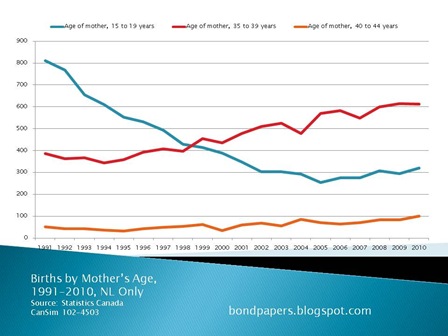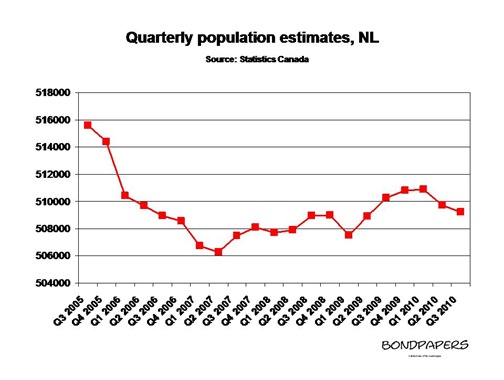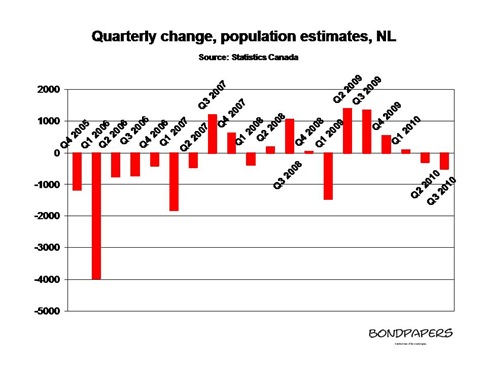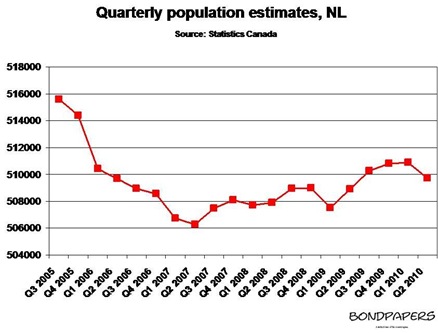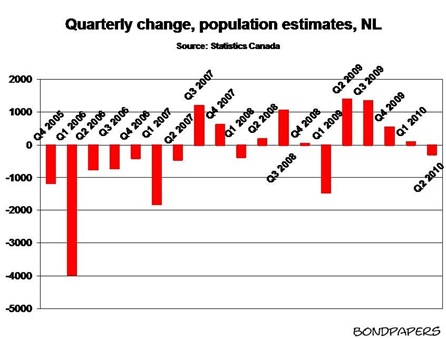Supposedly, there’s a baby boom in the province:
After years in decline, Newfoundland and Labrador’s birth rate has been steadily increasing in recent years — and the trend is expected to continue this year.
There isn’t really.
A steady increase or a boom.
And it isn’t clear from the Telegram front page story who expects the trend to continue.
First, the numbers.
In 2008, the number of live births in the province jumped by 300 to 4,905. In 2009, the number went up again by 35. That’s not a steady increase. It’s a big jump and then a tiny increase that is actually less than 10% of the total number of live births. Put another way, that’s almost a seven percent increase the first year and a point seven percent increase – 0.7% (less than one percent) - the next year.
This is not a trend.
It’s curious but it isn’t a trend.
As for what will happen in 2010, look at it this way: In 2008 and 2009, there were on average about 410 live births each month in the province, give or take. If the same birth rate carried on into 2010, we’d expect to see about 3900 live births by the middle of September (410 times 9.5) As the Telegram notes, we’ve only reached 3300 or so by that time in 2010.
So unless people were making like bunnies nine or 10 months ago or there are a crop of twins and trips out there no one really has talked up, the provincial birth rate seems to be on track to come in well below the 2008 and 2009 figure. That’s even allowing that October is one of the big baby months according to some analysis. In fact, if the current trend holds, the birth rate might well be back to where it was in 2007: around 4500 live births.
As for the Telly claim that someone expects the growth trend to continue, there’s no one quoted in the article who actually says that. The Telly article includes a reference to a 2009 news release by the provincial centre for health information, but your humble e-scribbler had a few choice words about that piece and its dubious commentary when it came out.
The article also makes an obligatory mention of the provincial government’s breeding incentive program. That’s the one Danny Williams announced during the 2007 campaign with the infamous quote “we can’t be a dying race”, but that’s another story.
Basically, there’s a cash bounty of $1,000 for every live birth or adoption in the province. Aside from the fact these sorts of programs don’t usually work, this one isn’t likely the cause for the spike in births since it doesn’t really change what the provincial government’s own statistics agency identified as long term trends affecting the population:
The number of births has been trending downward for four decades because of declining fertility rates and, more recently, a decline in the number of women of child-bearing age.
A grand for successful copulation doesn’t really get at the core problem fewer people at the right age to have children wanting fewer children than previous generations.
Most likely, the two year increase in live birth rates came from the increase in migration that started in 2007. All those young people who moved home to escape the recession may well have decided to carry on with their lives and have babies. Since out-migration seems to have picked up again, it would only make sense that the birth rate is down, as the Telegram’s statistics suggest.
The real stunning figures from the Telegram article though – and in some respects the real story – are in the print edition but not in the online version. In print, the Telly gave registered births in selected communities in 2009 and from January to September 2010. Labrador City, with about 8,000 people there and in neighbouring Wabush saw only 88 births registered in 2009. Bonavista had none in 2009 and has had two so far in 2010. Corner Brook (2006 population = 20,083) saw 650 births in 2009. meanwhile, St. John’s and its 100,000 or so residents registered 2629 births in 2009. For those keeping track that was 53% of the total number of live births in the province that year.
Outside the St. John’s census metropolitan region, large swaths of Newfoundland and Labrador are basically devoid of people under 50 years of age. Once bustling communities are collections of retirement homes. And in places like Grand falls-Windsor or Deer Lake, the local construction “boom” is pretty well all from retirees returning to the province from outside or people from smaller communities along the coast heading into the major centres.
What the demographic trends mean for the province is way more interesting than a minor – and temporary – shift in the birth rate. It’s also a subject the local crop of politicians, from the Old Man on down, quite clearly don’t have a sweet clue what to do about.
- srbp -
